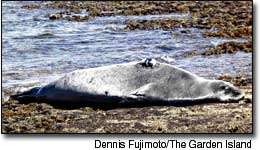That manmade thing glued to the back of that endangered Hawaiian monk seal doesn’t appear to bother him. Researchers know he’s a him because they netted and sedated the critter, glued the satellite-tracking device to his fur, took blood and
That manmade thing glued to the back of that endangered Hawaiian monk seal doesn’t appear to bother him.
Researchers know he’s a him because they netted and sedated the critter, glued the satellite-tracking device to his fur, took blood and tissue samples for his annual physical examination, then returned him to the wild.
Because the placement of the temporary, rectangular box affixed to the back of the seal known to researchers as TT40 hasn’t appeared to have altered his behavior, researchers aren’t worried that the box might cramp his style.
“We’re here to help ensure the survival of these animals,” said Charles Littnan, foraging ecologist for the protected species division of the National Marine Fisheries Service.
If it appeared the boxes disrupted or impaired normal seal activity, they would be removed, he indicated.
Littnan, Brad Ryan, Dr. Bob Braun and Dr. Bud Antonellis installed the tracking devices on four monk seals, two on Kaua‘i and two on O‘ahu, as part of a project to study and monitor the health of the endangered species.
Braun is the project’s primary researcher.
The satellite-tracking devices allow researchers to see where the seals feed, what they eat, where they go, and where they might come into contact with stream or river runoff that may give them fatal diseases, Littnan explained.
So far, there has been no differences in behaviors or survivability between seals equipped with the tracking devices and those without the devices, he said.
The instruments transmit data for around six months, and sometimes longer. They come off the seals either as a result of the seals rolling around on shore, or during their annual “catastrophic molt” when they shed their fur, said Littnan.
Researchers know based on information provided that the adult male seen near Salt Pond Beach Park is TT40, the number on the seal’s fin tag, because he hangs out on the Westside or South Shore, he said.
TT40 is healthy. “He’s still hauling out normally” to rest, Littnan said. “He’s not interested in humans.”
Associate Editor Paul C. Curtis may be reached at pcurtis@pulitzer.net or 245-3681 (ext. 224).


